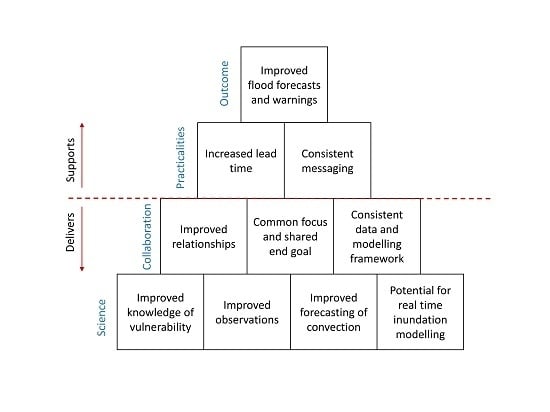Recommendations for Improving Integration in National End-to-End Flood Forecasting Systems: An Overview of the FFIR (Flooding From Intense Rainfall) Programme
Abstract
1. Introduction
2. Definition and Examples of Flooding From Intense Rainfall
3. End-to-End Flood Forecasting in Practice and FFIR Programme End-to-End Flood Forecasting System
3.1. Flood Forecasting in the UK Prior to FFIR
3.2. Improvements from the FFIR Proposed System
- improved quality of radar-derived rainfall.
- Greater usage, and more, river and geomorphic observations used within the models.
- More data being applied within the data assimilation system,
- better ways of treating the data used with the assimilation process including better treatment of correlated data.
- Improved representation of convection in kilometre-scale NWP models.
- Improved understanding of variability within kilometre-scale NWP models leading to more appropriate warnings.
- Improved infiltration rates for land surface modelling, leading to better links to the runoff for hydrological models,
- data assimilation of soil moisture in the model,
- more observations and data being fed into the national-scale flood models and catchment models,
- use of urban models for modelled inundation maps.
4. Improving the Lead Time for Flooding From Intense Rainfall Forecasts
5. Improvements and Lessons for Weather Forecasting Capabilities in an End-to-End System
5.1. Improved Rainfall Estimates from Radar
- The correction and improved quality of the radar-derived rainfall rates to account for non-meteorological effects (e.g., insects, birds, trees, buildings) on the signal [39]*.
- Using the radar as a radiometer for attenuation estimation, to correct in heavy rainfalls, but also monitor the radome as first described in [40].
- Using newly available polarisation parameters to improve the conversion from radar reflectivity to rainfall rate [39]*.
- Improved radar scanning strategy to allow for radar refractivity measurements to be taken and hence allow measurements of boundary-layer moisture from the radar [41]*.
- Better accounting for variations in the raindrop size distributions [39]*.
5.2. Improving the Initial Conditions for Weather Forecasts
5.3. Variability within Weather Forecasts
6. Downstream Applications in the End-to-End Forecast
6.1. Susceptibility Indicators in Landscapes
6.2. Improving Representation of Connectivity in Landscape Models
6.3. Public Engagement
7. Limitations and Recommendations
7.1. Limitations of the FFIR Programme
- backward compatibility of models — this limited the availability of data from past events to use for case studies and hence a full demonstration of the system was not viable;
- data consistency —much of the data had to be converted between different file formats for use in the different components of the chain which added complications and delays;
- understanding of operational requirements — towards the end of the chain many of the models were run offline so were not subject to the strong constraints or rigorous validation put on operational systems. Whilst this is viable for individual research areas, when combining could lead to compatibility problems due to updates in the operational system.
7.2. Recommendations
7.2.1. Propagation of Uncertainty
7.2.2. Improved Integration of End Users
7.2.3. Real-time Demonstration of an End-to-End Forecasting System
8. Summary
- Research into the propagation of uncertainty through the end-to-end modelling chain.
- Build closer relationships with and between users throughout the chain to better understand their requirements from an end-to-end system to inform their response to flood events.
- Real-time demonstration of the end-to-end system through testing on detailed case studies of flooding from intense rainfall events.
Author Contributions
Funding
Acknowledgments
Conflicts of Interest
References
- Hapuarachchi, H.A.P.; Wang, Q.J.; Pagano, T.C. A Review of Advances in Flash Flood Forecasting. Hydrol. Process. 2011, 25, 2771–2784. [Google Scholar] [CrossRef]
- Pitt, M. Learning Lessons from the 2007 Floods. An Independent Review by Sir Michael Pitt; Cabinet Office: London, UK, 2008. Available online: http://archive.cabinetoffice.gov.uk/pittreview/thepittreview.html (accessed on 27 October 2017).
- Chatterton, J.; Viavattene, C.; Morris, J.; Penning-Rowsell, E.C.; Tapsell, S.M. The Costs of the Summer 2007 Floods in England; Technical Report; Environment Agency: Bristol, UK, 2010. [Google Scholar]
- Hill, C.; Verjee, F.; Barrett, C. Flash Flood Early Warning System Reference Guide; University Corporation for Atmospheric Research: Boulder, CO, USA, 2010. [Google Scholar]
- Arheimer, B.; Lindström, G.; Olsson, J. A systematic review of sensitivities in the Swedish flood-forecasting system. Atmos. Res. 2011, 100, 275–284. [Google Scholar] [CrossRef]
- Pilling, C.; Dodds, V.; Cranston, M.; Price, D.; Harrison, T.; How, A. Chapter 9: Flood Forecasting—A National Overview for Great Britain. In Flood Forecasting; Adams, T.E., Pagano, T.C., Eds.; Academic Press: Boston, MA, USA, 2016; pp. 201–247. [Google Scholar] [CrossRef]
- Krajewski, W.F.; Ceynar, D.; Demir, I.; Goska, R.; Kruger, A.; Langel, C.; Mantilla, R.; Niemeier, J.; Quintero, F.; Seo, B.C.; et al. Real-time flood forecasting and information system for the state of Iowa. Bull. Am. Meteor. Soc. 2017, 98, 539–554. [Google Scholar] [CrossRef]
- Speight, L.; Cole, S.; Moore, R.; Pierce, C.; Wright, B.; Golding, B.; Cranston, M.; Tavendale, A.; Dhondia, J.; Ghimire, S. Developing surface water flood forecasting capabilities in Scotland: An operational pilot for the 2014 Commonwealth Games in Glasgow. J. Flood Risk Manag. 2018, 11, S884–S901. [Google Scholar] [CrossRef]
- Rabuffetti, D.; Ravazzani, G.; Barbero, S.; Mancini, M. Operational flood-forecasting in the Piemonte region–development and verification of a fully distributed physically-oriented hydrological model. Adv. Geosci. 2009, 17, 111–117. [Google Scholar] [CrossRef][Green Version]
- Golding, B.; Clark, P.; May, B. The Boscastle Flood: Meteorological Analysis of the Conditions Leading to Flooding on 16 August 2004. Weather 2005, 60, 230–235. [Google Scholar] [CrossRef]
- Newcastle City Council. Summer 2012 Flooding in Newcastle Upon Tyne; Technical Report; Newcastle City Council: Newcastle, UK, 2013. Available online: https://www.newcastle.gov.uk/sites/default/files/wwwfileroot/environment/environment/microsoft_word_-_summer_2012_flooding_report_-_final_-_july_2013.pdf (accessed on 27 October 2017).
- Essex, J. Coverack Flood Incident Review; Technical Report; JBA Consulting: Bodmin, UK, 2018. Available online: http://www.cornwall.gov.uk/media/32471292/coverack-flood-incident-review-technical-summary-report-2017s6474_v20-mar-2018.pdf (accessed on 27 October 2017).
- Thompson, R.J. A Summer of Floods! 2017. Available online: http://blogs.reading.ac.uk/flooding/2017/10/11/a-summer-of-floods/ (accessed on 1 July 2018).
- Hand, W.H.; Fox, N.I.; Collier, C.G. A Study of Twentieth-Century Extreme Rainfall Events in the United Kingdom with Implications for Forecasting. Meteor. Appl. 2004, 11, 15–31. [Google Scholar] [CrossRef]
- Blenkinsop, S.; Lewis, E.; Chan, S.C.; Fowler, H.J. Quality-control of an hourly rainfall dataset and climatology of extremes for the UK. Int. J. Climatol. 2017, 37, 722–740. [Google Scholar] [CrossRef] [PubMed]
- Archer, D.; Fowler, H. Characterising flash flood response to intense rainfall and impacts using historical information and gauged data in Britain. J. Flood Risk Manag. 2015. [Google Scholar] [CrossRef]
- Cuo, L.; Pagano, T.C.; Wang, Q. A Review of Quantitative Precipitation Forecasts and Their Use in Short- to Medium-Range Streamflow Forecasting. J. Hydrometeor. 2011, 12, 713–728. [Google Scholar] [CrossRef]
- Javelle, P.; Organde, D.; Demargne, J.; de Saint-Aubin, C.; Garandeau, L.; Janet, B.; Saint-Martin, C.; Fouchier, C. Development of a National Flash Flood Warning System in France Using the AIGA Method: First Results and Main Issues. In Proceedings of the EGU General Assembly Conference Abstracts, Vienna, Austria, 17–22 April 2016; p. EPSC2016-16433. [Google Scholar]
- Pagano, T.; Elliott, J.; Anderson, B.; Perkins, J. Chapter 1—Australian Bureau of Meteorology Flood Forecasting and Warning. In Flood Forecasting; Adams, T.E., Pagano, T.C., Eds.; Academic Press: Boston, MA, USA, 2016; pp. 3–40. [Google Scholar] [CrossRef]
- Dale, M.; Davies, P.; Harrison, T. Review of recent advances in UK operational hydrometeorology. Proc. Inst. Civ. Eng. 2012, 165, 55–64. [Google Scholar] [CrossRef]
- Stephens, E.; Cloke, H. Improving flood forecasts for better flood preparedness in the UK (and beyond). Geogr. J. 2014, 180, 310–316. [Google Scholar] [CrossRef]
- Bannister, R.N. A review of operational methods of variational and ensemble-variational data assimilation. Q. J. R. Meteorol. Soc. 2017, 143, 607–633. [Google Scholar] [CrossRef]
- Cullen, M.J.P.; Davies, T. A conservative split-explicit integration scheme with fourth-order horizontal advection. Q. J. R. Meteorol. Soc. 1991, 117, 993–1002. [Google Scholar] [CrossRef]
- Davies, T.; Cullen, M.; Malcolm, A.; Mawson, M.; Staniforth, A.; White, A.; Wood, N. A New Dynamical Core for the Met Office’s Global and Regional Modelling of the Atmosphere. Q. J. R. Meteorol. Soc. 2005, 131, 1759–1782. [Google Scholar] [CrossRef]
- Walters, D.; Wood, N.; Vosper, S.; Milton, S.; Bysouth, C.; Earnshaw, P.; Heming, J.; Mittermaier, M.; Sanchez, C.; Roberts, M.; et al. ENDGame: A New Dynamical Core for Seamless Atmospheric Prediction; Technical Report; Met Office: Exeter, UK, 2014. Available online: http://www.metoffice.gov.uk/binaries/content/assets/mohippo/pdf/s/h/endgamegovsci_v2.0.pdf (accessed on 27 October 2017).
- Wood, N.; Staniforth, A.; White, A.; Allen, A.; Diamantakisa, M.; Gross, M.; Melvin, T.; Smith, C.; Vosper, S.; Zerroukat, M.; et al. An Inherently Mass-Conserving Semi-Implicit Semi-Lagrangian Discretisation of the Deep-Atmosphere Global Nonhydrostatic Equations. Q. J. R. Meteorol. Soc. 2014, 140, 1505–1520. [Google Scholar] [CrossRef]
- Hagelin, S.; Son, J.; Swinbank, R.; McCabe, A.; Roberts, N.; Tennant, W. The Met Office convective-scale ensemble, MOGREPS-UK. Q. J. R. Meteorol. Soc. 2017, 143, 2846–2861. [Google Scholar] [CrossRef]
- Cole, S.J.; Moore, R.J. Distributed hydrological modelling using weather radar in gauged and ungauged basins. Adv. Water Resour. 2009, 32, 1107–1120. [Google Scholar] [CrossRef]
- Price, D.; Hudson, K.; Boyce, G.; Schellekens, J.; Moore, R.J.; Clark, P.; Harrison, T.; Connolly, E.; Pilling, C. Operational use of a grid-based model for flood forecasting. Proc. Inst. Civ. Eng. Water Manag. 2012, 165, 65–77. [Google Scholar] [CrossRef]
- Mason, D.C.; Garcia-Pintado, J.; Cloke, H.L.; Dance, S.L. Evidence of a topographic signal in surface soil moisture derived from ENVISAT ASAR wide swath data. Int. J. Appl. Earth Obs. Geoinf. 2016, 45, 178–186. [Google Scholar] [CrossRef]
- Largeron, C.; Cloke, H.; Verhoef, A.; Martinez-de-la Torre, A.; Mueller, A. Impact of the Representation of the Infiltration on the River Flow during Intense Rainfall Events in JULES; European Centre for Medium-Range Weather Forecasts: Reading, UK, 2018. [Google Scholar]
- Hawcroft, M.; Shaffrey, L.; Hodges, K.I.; Dacre, H. How much Northern Hemisphere precipitation is associated with extratropical cyclones? Geophys. Res. Lett. 2012, 39. [Google Scholar] [CrossRef]
- Lavers, D.L.; Allan, R.P.; Wood, E.; Wade, A. Winter floods in Britain are connected to atmospheric rivers. Geophys. Res. Lett. 2011, 38. [Google Scholar] [CrossRef]
- Champion, A.J.; Allan, R.P.; Lavers, D.L. Atmospheric Rivers do not explain UK Summer Extreme Rainfall. J. Geophys. Res. Atmos. 2015, 120, 6371–6741. [Google Scholar] [CrossRef]
- Lenderink, G.; Fowler, H. Hydroclimate: Understanding rainfall extremes. Nat. Clim. Chang. 2017, 7. [Google Scholar] [CrossRef]
- Chan, S.C.; Kahana, R.; Kendon, E.J.; Fowler, H.J. Projected changes in extreme precipitation over Scotland and Northern England using a high-resolution regional climate model. Clim. Dyn. 2018. [Google Scholar] [CrossRef]
- Champion, A.J.; Blenkinsop, S.; Li, X.; Fowler, H.J. Synoptic-scale precursors of extreme UK summer 3-hourly rainfall. J. Geophys. Res. Atmos. 2019, in press. [Google Scholar] [CrossRef]
- Wang, Y.; Chandrasekar, V. Quantitative Precipitation Estimation in the CASA X-band Dual-Polarization Radar Network. J. Atmos. Ocean. Technol. 2010, 27, 1665–1676. [Google Scholar] [CrossRef]
- Darlington, T.; Adams, D.; Best, S.; Husnoo, N.; Lyons, S.; Norman, K. Optimising the Accuracy of Radar Products With Dual Polarisation :Project Benefits; Technical Report; Met Office: Exeter, UK, 2016. [Google Scholar]
- Thompson, R.; Illingworth, A.; Ovens, J. Emission: A simple new technique to correct rainfall estimates from attenuation due to both the radome and heavy rainfall. In Weather Radar and Hydrology; Moore, R.J., Cole, S.J., Illingworth, A.J., Eds.; IAHS Press: Wallingford, UK, 2012; pp. 39–44. [Google Scholar]
- Dance, S.L.; Ballard, S.P.; Bannister, R.N.; Clark, P.; Cloke, H.L.; Darlington, T.; Flack, D.L.A.; Gray, S.L.; Hawkness-Smith, L.; Husnoo, N.; et al. Improvements in forecasting intense rainfall: Results from the FRANC (Forecasting Rainfall exploiting new data Assimilation techniques and Novel observations of Convection) project. Atmosphere 2019, 10, 125. [Google Scholar] [CrossRef]
- Simonin, D.; Pierce, C.; Roberts, N.; Ballard, S.P.; Li, Z. Performance of Met Office hourly cycling NWP-based nowcasting for precipitation forecasts. Q. J. R. Meteorol. Soc. 2017, 143, 2862–2873. [Google Scholar] [CrossRef]
- Jones, C.; Macpherson, B. A latent heat nudging scheme for the assimilation of precipitation data into an operational mesoscale model. Meteorol. Appl. 1997, 4, 269–277. [Google Scholar] [CrossRef]
- Waller, J.A.; Dance, S.L.; Nichols, N.K. Theoretical insight into diagnosing observation error correlations using observation-minus-background and observation-minus-analysis statistics. Q. J. R. Meteorol. Soc. 2016, 142, 418–431. [Google Scholar] [CrossRef]
- Waller, J.A.; Dance, S.L.; Nichols, N.K. On diagnosing observation error statistics in localized ensemble data assimilation. Q. J. R. Meteorol. Soc. 2017. [Google Scholar] [CrossRef]
- Janjić, T.; Bormann, N.; Bocquet, M.; Carton, J.A.; Cohn, S.E.; Dance, S.L.; Losa, S.N.; Nichols, N.K.; Potthast, R.; Waller, J.A.; et al. On the representation error in data assimilation. Q. J. R. Meteorol. Soc. 2018, 144, 1257–1278. [Google Scholar] [CrossRef]
- Waller, J.A.; Simonin, D.; Dance, S.L.; Nichols, N.K.; Ballard, S.P. Diagnosing observation error correlations for Doppler radar radial winds in the Met Office UKV model using observation-minus-background and observation-minus-analysis statistics. Mon. Wea. Rev. 2016, 144, 3533–3551. [Google Scholar] [CrossRef]
- Waller, J.A.; Ballard, S.P.; Dance, S.L.; Kelly, G.; Nichols, N.K.; Simonin, D. Diagnosing Horizontal and Inter- Channel Observation Error Correlations for SEVIRI Observations Using Observation-Minus-Background and Observation-Minus-Analysis Statistics. Remote Sens. 2016, 8, 581. [Google Scholar] [CrossRef]
- Cordoba, M.; Dance, S.L.; Kelly, G.A.; Nichols, N.K.; Waller, J.A. Diagnosing Atmospheric Motion Vector observation errors for an operational high resolution data assimilation system. Q. J. R. Meteorol. Soc. 2017, 143, 333–341. [Google Scholar] [CrossRef]
- Fowler, A.M.; Dance, S.L.; Waller, J.A. On the interaction of observation and prior error correlations in data assimilation. Q. J. R. Meteorol. Soc. 2018, 144, 48–62. [Google Scholar] [CrossRef]
- Simonin, D.; Waller, J.A.; Ballard, S.P.; Dance, S.; Nichols, N. Doppler Radial Wind Spatially Correlated Observation Error Statistics: Operational Implementation and Initial Results; Met Office, University of Reading: Reading, UK, 2018. [Google Scholar]
- Lean, H.W.; Clark, P.A.; Dixon, M.; Roberts, N.M.; Fitch, A.; Forbes, R.; Halliwell, C. Characteristics of high-resolution versions of the Met Office Unified Model for forecasting convection over the United Kingdom. Mon. Weather Rev. 2008, 136, 3408–3424. [Google Scholar] [CrossRef]
- Clark, P.; Roberts, N.; Lean, H.; Ballard, S.P.; Charlton-Perez, C. Convection-Permitting Models: A Step- Change in Rainfall Forecasting. Meteor. Appl. 2016, 23, 165–181. [Google Scholar] [CrossRef]
- Lorenz, E.N. The Predictability of a Flow Which Possesses Many Scales of Motion. Tellus 1969, 21, 289–307. [Google Scholar] [CrossRef]
- Hohenegger, C.; Lüthi, D.; Schär, C. Predictability Mysteries in Cloud-Resolving Models. Mon. Wea. Rev. 2006, 134, 2095–2107. [Google Scholar] [CrossRef]
- Leith, C. Theoretical Skill of Monte Carlo Forecasts. Mon. Weather Rev. 1974, 102, 409–418. [Google Scholar] [CrossRef]
- Flack, D.L.; Gray, S.L.; Plant, R.S.; Lean, H.W.; Craig, G.C. Convective-Scale Perturbation Growth across the Spectrum of Convective Regimes. Mon. Weather Rev. 2018, 146, 387–405. [Google Scholar] [CrossRef]
- Flack, D.; Plant, R.; Gray, S.; Lean, H.; Keil, C.; Craig, G. Characterisation of Convective Regimes over the British Isles. Q. J. R. Meteorol. Soc. 2016, 142, 1541–1553. [Google Scholar] [CrossRef]
- Clark, P.A.; Halliwell, C.; Flack, D.L.A. A Simple, Physically-Based, Stochastic Boundary-Layer Parametrization. Part I: The Scheme Formulation and Sensitivity. 2019; in preparation. [Google Scholar]
- Flack, D.L.A.; Clark, P.A.; Halliwell, C.; Roberts, N.M.; Gray, S.L.; Plant, R.S.; Lean, H.W. A Simple, Physically-Based, Stochastic Boundary-Layer Parametrization. Part II: Application Within a Convective-Sacle Super Ensemble. 2019, in preparation.
- Collier, C.; Fox, N. Assessing the flooding susceptibility of river catchments to extreme rainfall in the United Kingdom. Int. J. River Basin Manag. 2003, 1, 225–235. [Google Scholar] [CrossRef]
- Marchi, L.; Borga, M.; Preciso, E.; Gaume, E. Characterisation of selected extreme flash floods in Europe and implications for flood risk management. J. Hydrol. 2010, 394, 118–133. [Google Scholar] [CrossRef]
- Dale, M.; Dempsey, P.; Dent, J. Extreme Rainfall Event Recognition: Phase 2 Work Package 5–Establishing a User Requirement for a Decision-Support Tool. In Research and Development Technical Report FD2208 of Defra/Environment Agency Flood and Coastal Defence R&D Programme; Department of the Environment, Food and Rural Affairs: London, UK, 2004. [Google Scholar]
- Chang, T.J.; Wang, C.H.; Chen, A.S.; Djordjević, S. The effect of inclusion of inlets in dual drainage modelling. J. Hydrol. 2018, 559, 541–555. [Google Scholar] [CrossRef]
- Wang, Y.; Chen, A.S.; Fu, G.; Djordjević, S.; Zhang, C.; Savić, D.A. An integrated framework for high-resolution urban flood modelling considering multiple information sources and urban features. Environ. Model. Softw. 2018, 107, 85–95. [Google Scholar] [CrossRef]
- Chen, A.; Hsu, M.; Chen, T.; Chang, T. An integrated inundation model for highly developed urban areas. Water Sci. Technol. 2005, 51, 221–229. [Google Scholar] [CrossRef]
- Xia, X.; Liang, Q.; Ming, X.; Hou, J. An efficient and stable hydrodynamic model with novel source term discretization schemes for overland flow and flood simulations. Water Resour. Res. 2017, 53, 3730–3759. [Google Scholar] [CrossRef]
- Beven, K.; Freer, J. A dynamic topmodel. Hydrol. Process. 2001, 15, 1993–2011. [Google Scholar] [CrossRef]
- Bates, P.D.; Horritt, M.S.; Fewtrell, T.J. A simple inertial formulation of the shallow water equations for efficient two-dimensional flood inundation modelling. J. Hydrol. 2010, 387, 33–45. [Google Scholar] [CrossRef]
- Skinner, C. SeriousGeoGames—Flash Flood Living Manual; Zenodo: Geneva, Switzerland, 2018. [Google Scholar] [CrossRef]
- Milan, D.J. Geomorphic impact and system recovery following an extreme flood in an upland stream: Thinhope Burn, northern England, UK. Geomorphology 2012, 138, 319–328. [Google Scholar] [CrossRef]
- Skinner, C. Riding the (flood) wave: The Flash Flood! desktop application. Teach. Geogr. Spring 2018, 43, 28–31. [Google Scholar]
- Ebert, E.E. Neighborhood verification: A strategy for rewarding close forecasts. Wea. Forecast. 2009, 24, 1498–1510. [Google Scholar] [CrossRef]
- Lewis, H.W.; Castillo Sanchez, J.M.; Graham, J.; Saulter, A.; Bornemann, J.; Arnold, A.; Fallmann, J.; Harris, C.; Pearson, D.; Ramsdale, S.; et al. The UKC2 regional coupled environmental prediction system. Geosci. Model Dev. 2018, 11, 1–42. [Google Scholar] [CrossRef]
- Lewis, H.W.; Castillo Sanchez, J.M.; Arnold, A.; Fallmann, J.; Saulter, A.; Graham, J.; Bush, M.; Siddorn, J.; Palmer, T.; Lock, A.; et al. The UKC3 regional coupled environmental prediction system. Geosci. Model Dev. Discuss. 2018, 2018, 1–67. [Google Scholar] [CrossRef]
- Cole, S.J.; Moore, R.J.; Aldridge, T.A.; Gunawan, O.; Balmforth, H.; Hunter, N.; Mooney, J.; Lee, D.; Fenwick, K.; Price, D.; et al. Natural Hazards Partnership Surface Water Flooding Hazard Impact Model: Phase 2 Final Report; Technical Report; Natural Hazards Partnership: Wallingford, UK, 2016; Available online: http://www.naturalhazardspartnership.org.uk/wp-content/uploads/2016/10/NHP-HIM-Surface-Water-Flooding-Phase-2-Final-Report.pdf (accessed on 20 February 2019).
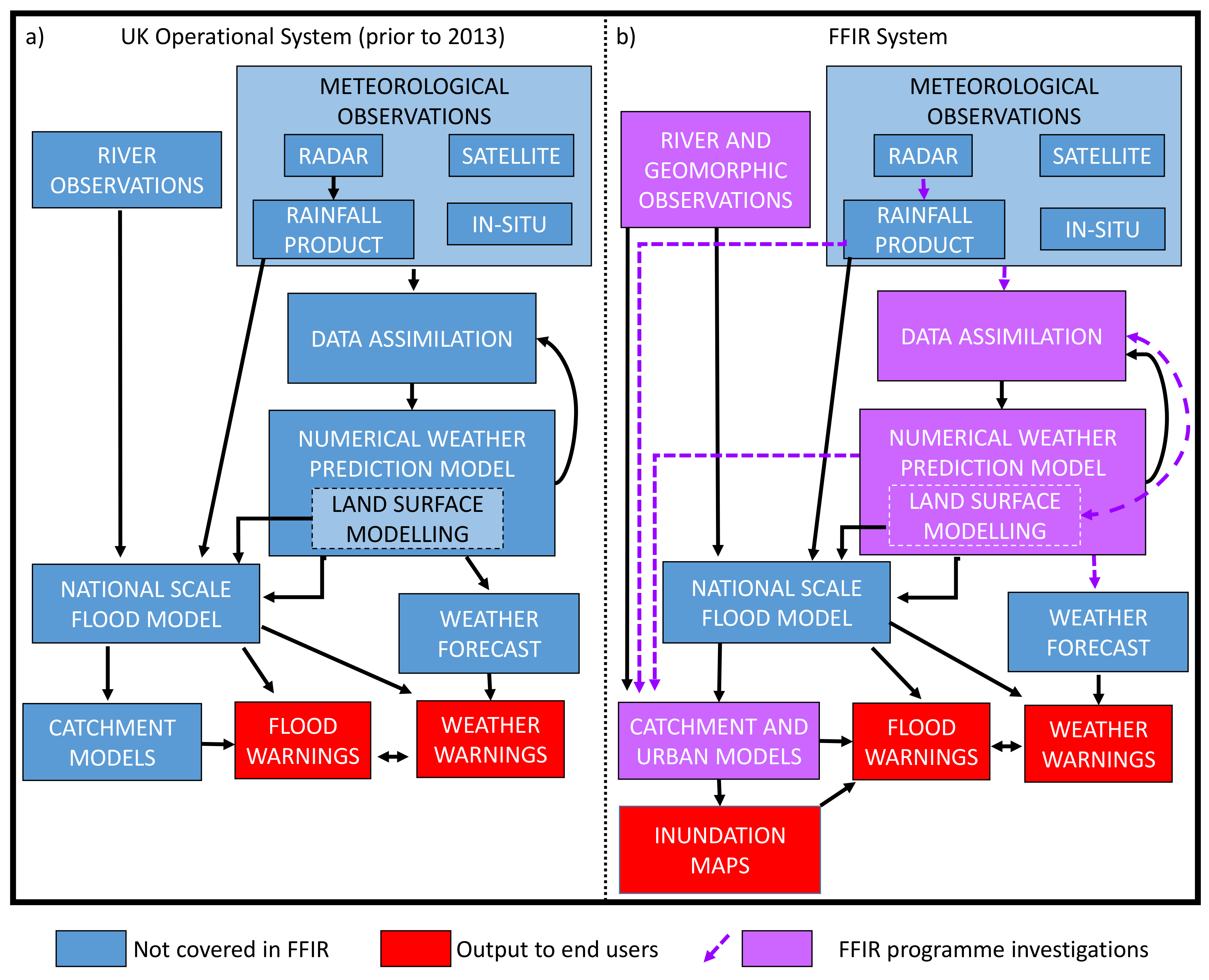
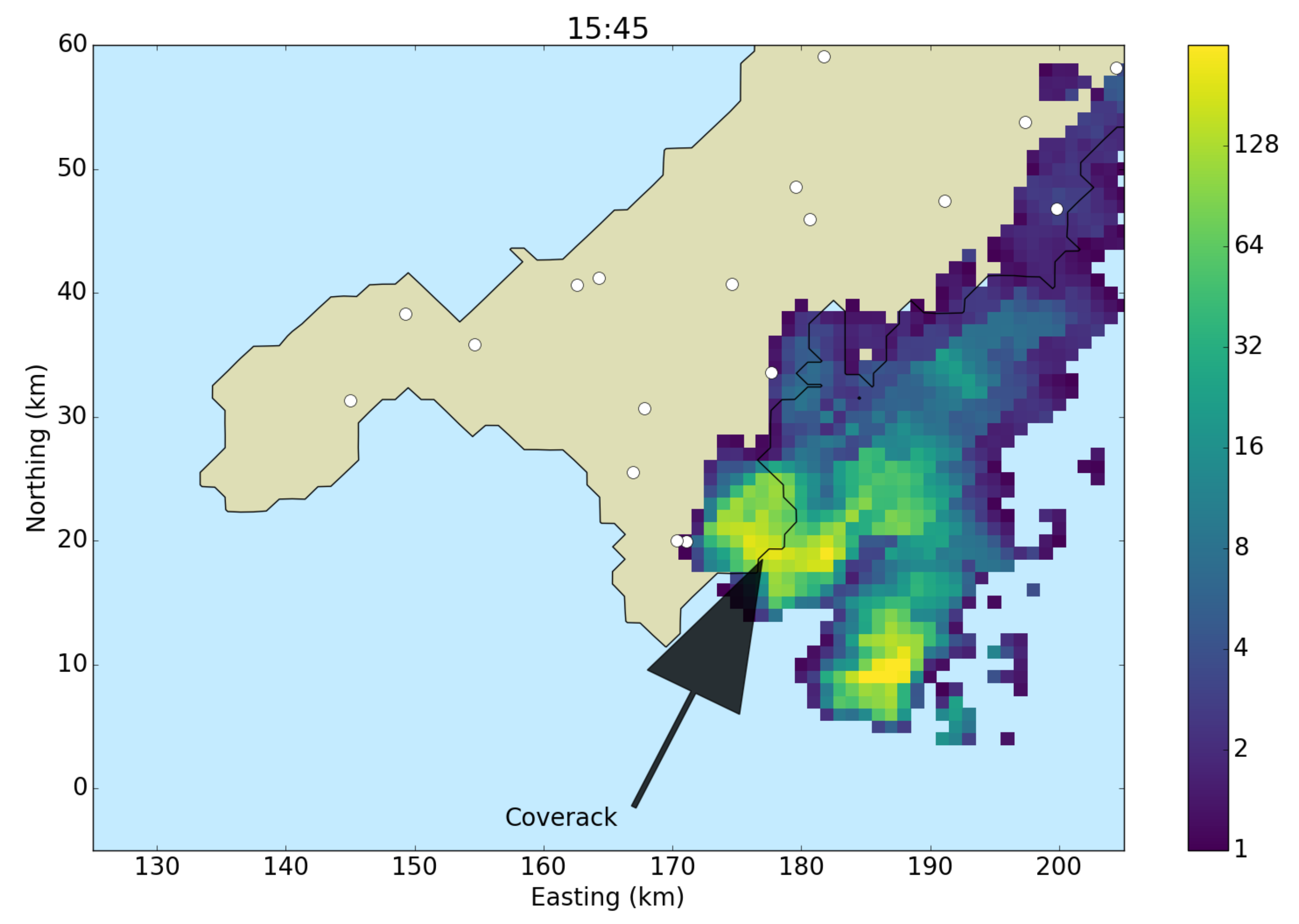
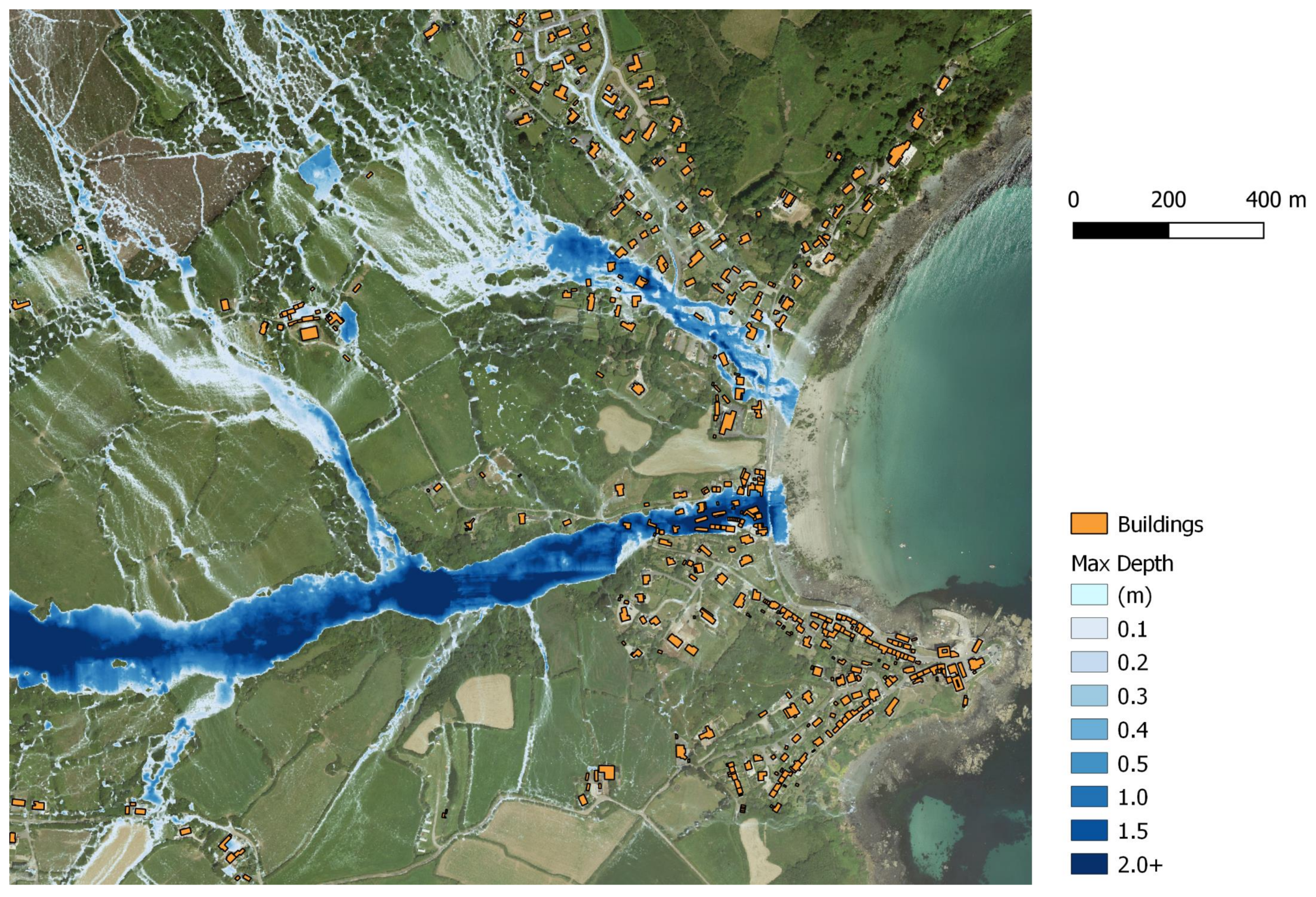

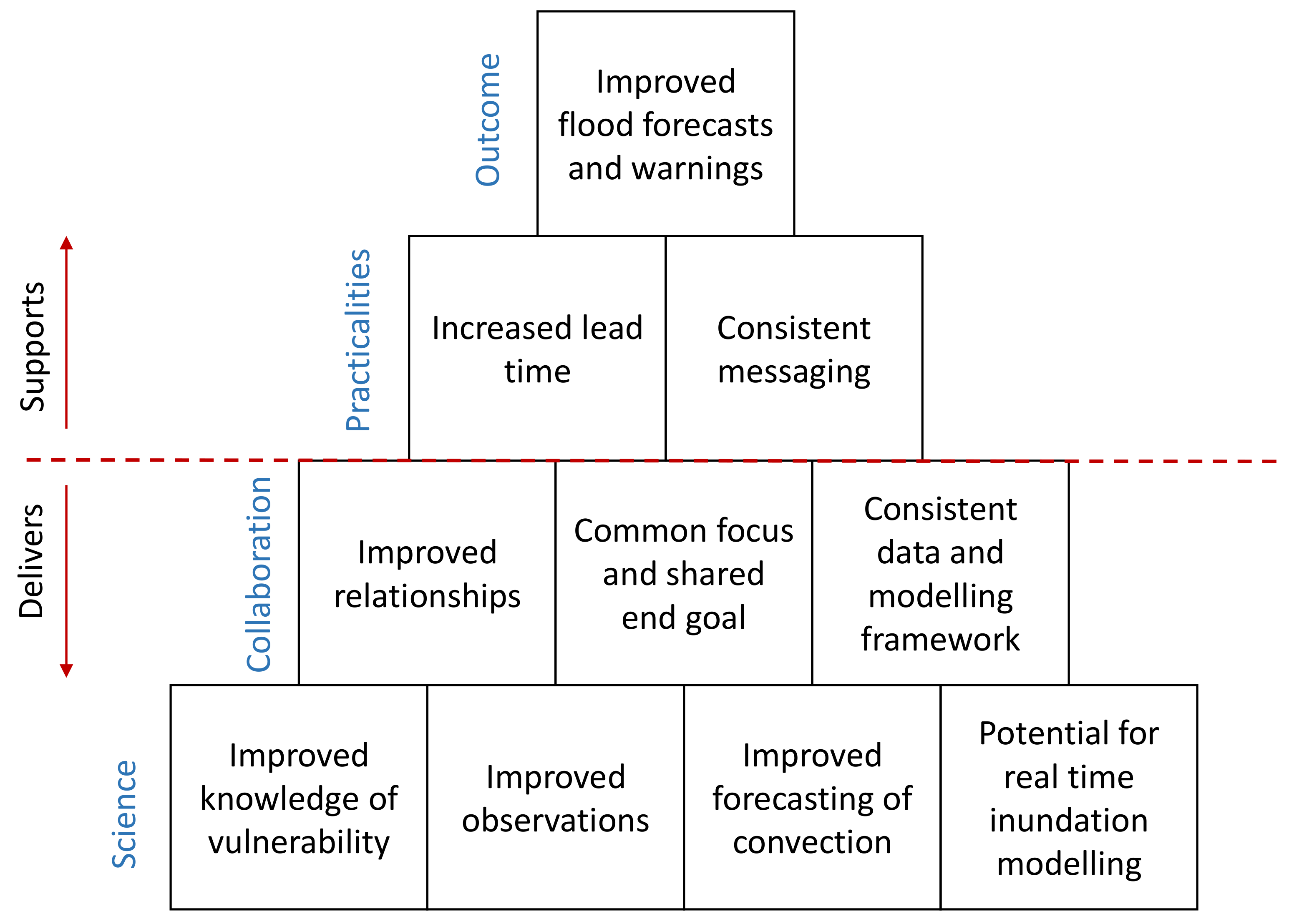
| Event | Flood Type | Rainfall Type | Rainfall Total (mm) | Rainfall Duration (h) |
|---|---|---|---|---|
| Boscastle 2004 [10] | Rapid-rate-of-rise river flooding | Convective | 183 | 5 |
| Newcastle 2012 [11] | Surface-water flooding | Convective | 50 | 2 |
| Coverack 2017 [12] | Rapid-rate-of-rise river flooding | Convective | 165–201 | 3 |
| Reading 2017 [13] | Surface-water flooding | Convective | 39 | 1 |
| Rainfall (mm) | Runoff (mm) | |
|---|---|---|
| Maximum | 22.8 | 83.3 |
| Mean | 2.4 | 3.3 |
| Minimum | 0.0 | 0.0 |
© 2019 by the authors. Licensee MDPI, Basel, Switzerland. This article is an open access article distributed under the terms and conditions of the Creative Commons Attribution (CC BY) license (http://creativecommons.org/licenses/by/4.0/).
Share and Cite
Flack, D.L.A.; Skinner, C.J.; Hawkness-Smith, L.; O’Donnell, G.; Thompson, R.J.; Waller, J.A.; Chen, A.S.; Moloney, J.; Largeron, C.; Xia, X.; et al. Recommendations for Improving Integration in National End-to-End Flood Forecasting Systems: An Overview of the FFIR (Flooding From Intense Rainfall) Programme. Water 2019, 11, 725. https://doi.org/10.3390/w11040725
Flack DLA, Skinner CJ, Hawkness-Smith L, O’Donnell G, Thompson RJ, Waller JA, Chen AS, Moloney J, Largeron C, Xia X, et al. Recommendations for Improving Integration in National End-to-End Flood Forecasting Systems: An Overview of the FFIR (Flooding From Intense Rainfall) Programme. Water. 2019; 11(4):725. https://doi.org/10.3390/w11040725
Chicago/Turabian StyleFlack, David L. A., Christopher J. Skinner, Lee Hawkness-Smith, Greg O’Donnell, Robert J. Thompson, Joanne A. Waller, Albert S. Chen, Jessica Moloney, Chloé Largeron, Xilin Xia, and et al. 2019. "Recommendations for Improving Integration in National End-to-End Flood Forecasting Systems: An Overview of the FFIR (Flooding From Intense Rainfall) Programme" Water 11, no. 4: 725. https://doi.org/10.3390/w11040725
APA StyleFlack, D. L. A., Skinner, C. J., Hawkness-Smith, L., O’Donnell, G., Thompson, R. J., Waller, J. A., Chen, A. S., Moloney, J., Largeron, C., Xia, X., Blenkinsop, S., Champion, A. J., Perks, M. T., Quinn, N., & Speight, L. J. (2019). Recommendations for Improving Integration in National End-to-End Flood Forecasting Systems: An Overview of the FFIR (Flooding From Intense Rainfall) Programme. Water, 11(4), 725. https://doi.org/10.3390/w11040725





